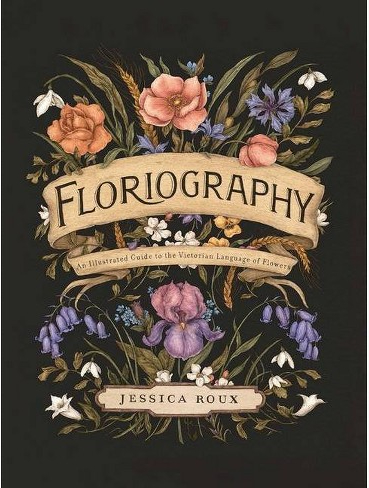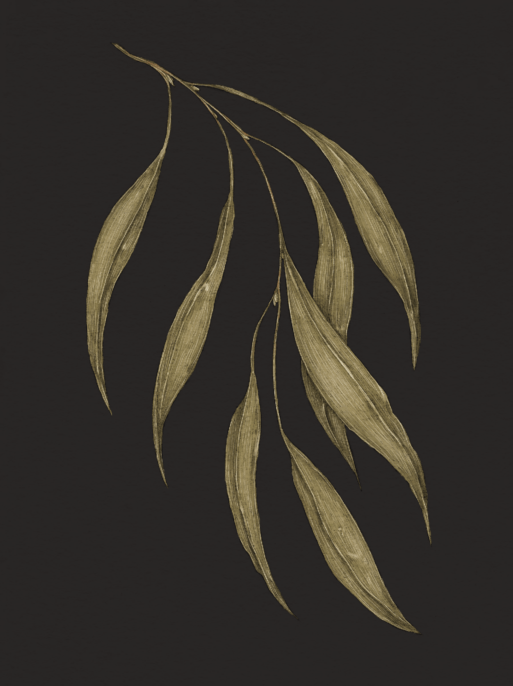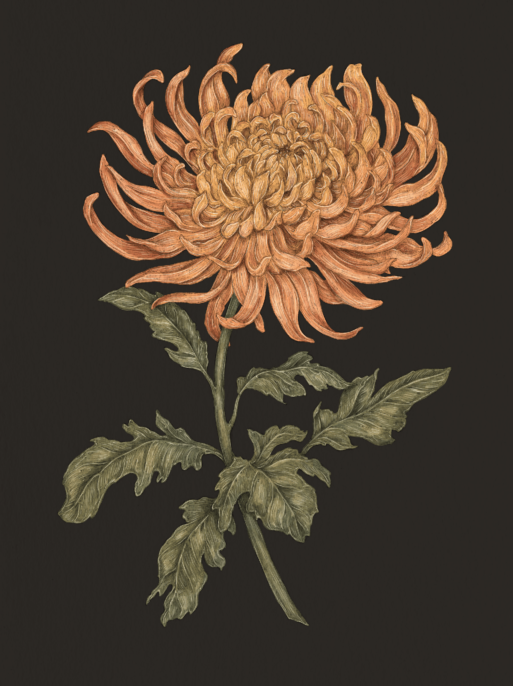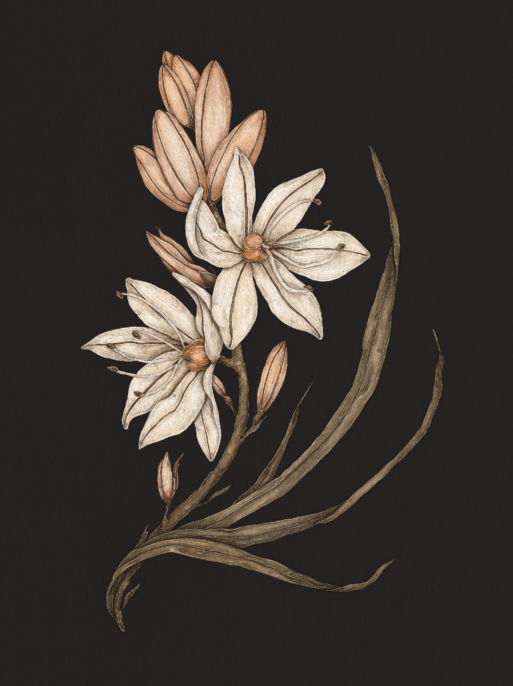
Jessica Roux poses amid the greenery.
Jessica Roux is a Nashville-based freelance illustrator who is a self-proclaimed plant and animal enthusiast. She is the author of and co-author of several books, including “Floriography: An Illustrated Guide to the Victorian Language of Flowers.” SevenPonds sat down with Jessica today to talk about her book and her life-long love of the natural world. We also discussed the meaning of flowers and how flowers have come to be such a large part of many rituals and ceremonies around death, loss and grief across the globe.
Editor’s note: This interview has been edited for length and readability.
Hi Jessica. Can we start off by talking about what got you interested in writing your book?
I was always interested in learning the historical context behind the meaning of flowers. And I have wanted to dive into writing and illustrating books for a long time. So my literary agent and I sat down and put together an idea for Floriography … and my publisher picked it up, which I’m very grateful for. I started with a list of about 100 flowers that I wanted to uncover the meanings for, but I still haven’t found everything. Some of it we just don’t know and probably never will. But I had a lot of fun looking into it and finding what’s out there.
What do you think it is about flowers that resonates with people and draws them to use them as a means of communication?
I think a lot of people are just attracted to the beauty of flowers. They come in so many different colors and shapes and sizes … the variety appeals to people. And during the Victorian Era in Europe some very specific things happened that caused people to become more interested in flowers. For example, the government eliminated the so-called “glass tax” so people could start building greenhouses and importing flowers from Asia and the Americas, something that hadn’t been possible before. I think that led to a greater appreciation of the variety and beauty of flowers that were available. People in the Victorian era also began to explore houseplants and the concept of bringing the outdoors into their homes. That mindset began to fade around the time of the first World War, since growing food was a greater priority than growing decorative plants. But it’s still interesting to see the history behind it and to realize that so many traditions — for example, red roses on Valentines Day — that started in the Victorian era have survived through the years.

Jessica’s book explores the meaning of flowers and offers some helpful tips about their use in modern-day life.
Something you talked about in the introduction to your book is the fact that people often can’t articulate their feelings verbally, and often use flowers to communicate what they can’t say out loud. Why do you think that is?
I think especially in the Victorian era people were kind of repressed, and open displays of affection weren’t really allowed or socially acceptable so flowers became a means of self-expression. That was also a time when people became more interested in gardening and that interest is still strong today. During the pandemic, for example, many people became interested in growing plants and flowers … partly for enjoyment, but also as a means of improving their mental health. Working outside a few hours a day and having your hands in the dirt is very therapeutic. And nurturing something and watching it grow and thrive is also immensely satisfying. So it’s a tradition that has lasted through the centuries and is still popular today.
We humans are always dealing with these incredibly complex emotions like grief and love and loss. Do you think flowers somehow give us the tools to express those feelings when we can’t find the words?
It can be so uncomfortable to talk about some of these topics, especially grief and death and dying. It’s hard to articulate how you feel, and we repeat these same phrases over and over again. Flowers are a more comfortable way of communicating for a lot of people.
As you know, our website deals with the topics of death and grief and loss. And so before I go into some general questions about the meanings of certain flowers, I wanted to ask you to speak in a more general way about how flowers came to be such an important part of death rituals and traditions.
Well, during the Victorian Era death was much more a part of daily life. The child death rate was much higher, for example, and death was literally something that people encountered almost every day. And then Queen Victoria lost her husband, Prince Albert, and she really brought the idea of mourning openly into the public eye. This was also the time when funerals and funeral arrangements became more and more elaborate. Large displays of flowers and flower arrangements were a big part of that.

Willow leaves are symbolic of loss and grief in many traditions.
Can you speak a little bit about the meaning of specific flowers, especially those that have some significance around loss and grief?
One of the first that comes to mind is marigolds, which are a big part of the Day of the Dead celebrations in Mexico. In that tradition, their bright colors are believed to guide the spirits of the dead who come to visit the living during the holiday. Not coincidentally, they are also one of the flowers that are most abundant in Mexico during that time of the year.
Another flower that has special significance in mourning rituals is the chrysanthemum, which was a very popular funeral flower in Europe during the Victorian era. It is also abundant in the fall, which is when Europe celebrates All Soul’s Day (November 1).
Willows are also popular symbols in death and funeral traditions throughout Europe and even the U.S. They are planted in many European graveyards, and images of weeping willows are very common on mourning jewelry and headstones from Victorian times There are even some examples of mourning jewelry made from a dead loved one’s hair that is designed in the shape of willow branches, which I find particularly beautiful. Cyprus trees are also common in European graveyards, a tradition that can be traced back to ancient Greece, when cyprus boughs were placed on the doors of households in mourning.
That’s fascinating. Anything else?
Another flower I’m particularly fond of is yarrow (which symbolically means “cure for a broken heart”). Its scientific name is “Achillea,” and legend has it that the great Trojan warrior Achilles used it for its medicinal properties when he was injured on the battlefield. Interestingly, it is still found in many pharmaceutical products and is used in various ways by many holistic healers today.

Chrysanthemums have long been a favorite funeral flower in Europe and the United States.
I also love asphodel flowers; they mean “my regrets follow you to the grave.” They are beautiful delicate pink and white star-shaped flowers which, in Greek mythology, were believed to grow in the underworld in a sort of purgatory where souls were left to contemplate their mistakes and regrets.
Carnations are also very symbolic of sorrow and sadness and are often sent to offer condolences to the bereaved. In the ancient Christian tradition, it was believed that carnations sprung from where Jesus’ mother Mary shed tears after her son’s death.
And of course there are forget-me-nots, whose meaning is obvious. And also pansies, whose name derives from the French word “pensee” for “thought” and mean, literally “you’re in my thoughts.”
Is there anything else you would like to reflect on in terms of how we use flowers — gifting them, displaying them, putting them on graves, etc.?
Really, flowers can be anything we want them to be, anything a person is comfortable with. They can be a beautiful expression of love or sympathy, and they are as wonderful to give as to receive. For me, they are just enormously comforting, and I love having them around.
I’d like to ask you a little bit about your book. Do you have any thoughts about how you would like it to be received by the public or how you imagine someone using it?
As I was writing the book, I hoped that it would be a wonderful resource for people, and that has actually proven to be the case. Some people have told me they just like to flip through and look at the illustrations and learn about the kinds of flowers that exist and what they mean. I’ve also had florists tell me they have used it to help clients select flowers for a special occasion, like a wedding or a memorial. I also particularly love when another artist tells me they used my book to help them create a work of art. I think there’s a common perception that flowers in art are sort of meaningless — they’re just pretty to look at and nothing more. But there’s actually so much more to them than that — depth and meaning and history. I love to explore that and to share that with the world.
Are there any other ways that you think flowers can be used to provide comfort to people who may not be grieving a death but who are having a hard time — maybe dealing with a serious illness or a significant loss?
I think flowers are always comforting and meaningful. And there is something about the life cycle of a lot of flowers that in some ways mirrors the struggles we face in our lives. We plant tulip bulbs in the fall, and they have to withstand the winter cold in order to produce beautiful blooms in the spring. And a lot of spring flowers have developed meanings that are symbolic of that. They really do illustrate the way in which humans, especially in ancient times, struggled to endure the cold, dark winters with very scarce resources and come out the new season of life and joy. That’s something that has a lot of meaning for me.

In ancient times, the asphodel flower was believed to grow in the underworld as a symbol of penitence and regret.
I also include in the book suggestions for creating floral arrangements for different occasions. One of my favorite bouquets is “forgotten obligations” or “apology flowers.” There’s also a “bouquet for bitter ends,” which I love because it emphasizes how creating a beautiful flower arrangement can help us release the negative energy we experience when things go wrong — challenge that sadness or sorrow into something healing so we can let it go. That can be very cathartic.
Anything else about you personally you want to share, like why you love flowers so much?
When I was a kid I was forced to garden with my parents. Every Sunday after church we would go to Home Depot or Lowes garden center and then work in the garden in the afternoon. And I hated that! I hated the dirt under my nails and getting sunburned and everything about it.
Then I went off to college, and after graduation I spent a couple of years living in Brooklyn and began to really miss having flowers and plants around. And then I moved to Florida for my husband’s work, and you can grow anything there. And we were renting a place from a guy who did landscaping and had all kinds of trees and plants and flowers everywhere. So we started a little garden, and I found it so fulfilling and so challenging. I learned so much, mostly by trial and error — like “when is the right time to plant Brussel sprouts?” or “Why did this plant die?” So I kind of fell in love with gardening.
There is also something about growing plants and flowers that is almost anathemic to our materialistic consumer culture and very freeing too.
Yes. Just being out in nature and working in the dirt and being out in the fresh air is so good for your mental health. And then when you plant something and nurture it and it finally produces flowers or fruit or beautiful foliage, it is a really joyful experience. I recommend it for everyone!

 Flowers for Comfort: How Can We Use Nature to Heal from Grief?
Flowers for Comfort: How Can We Use Nature to Heal from Grief?


 “Help Me, Helen”
“Help Me, Helen”
 Recovering Cremation Remains After the Los Angeles Fires
Recovering Cremation Remains After the Los Angeles Fires
 “As Tears Go By” by Marianne Faithfull
“As Tears Go By” by Marianne Faithfull














